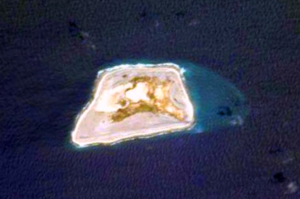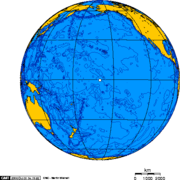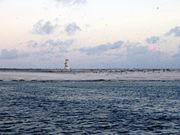Jarvis Island
2008/9 Schools Wikipedia Selection. Related subjects: Geography of Oceania (Australasia)
Jarvis Island (also formerly known as Bunker Island) is an uninhabited 4.5 square kilometer coral island located in the South Pacific Ocean at about halfway between Hawaii and the Cook Islands. It is an unincorporated territory of the United States administered from Washington, D.C. by the United States Fish and Wildlife Service of the United States Department of the Interior as part of the National Wildlife Refuge system. Jarvis is one of the southern Line Islands and for statistical purposes is also grouped as one of the United States Minor Outlying Islands.
Geography and ecology
There are no ports or harbors but a few offshore anchorage spots have been noted. Swift currents are a hazard. There is a boat landing area in the middle of the western shoreline near a crumbling day beacon and another near the southwest corner of the island. The centre of the island is a dried lagoon where deep guano deposits later gathered and were mined for about 20 years during the 19th century. The island has a tropical desert climate with high daytime temperatures, constant wind and strong sun. Nights however are quite cool. The ground is mostly sandy and reaches seven meters (23 feet) at its highest. The low-lying coral island has long been noted as hard to sight from small ships and is surrounded by a narrow fringing reef.
Located only 25 miles south of the equator Jarvis has no natural fresh water lens and scant rainfall. The outcome is a very bleak, flat landscape without any plant larger than a shrub. There is no evidence the island has ever supported a self-sustaining human population. Its sparse bunch grass, prostrate vines and low-growing shrubs are primarily a nesting, roosting and foraging habitat for seabirds, shorebirds and marine wildlife.
History
The island's first known sighting by Europeans was on 21 August 1821 by the British ship Eliza Francis (or Eliza Frances) owned by Edward, Thomas and William Jarvis and commanded by Captain Brown. In March 1857 the uninhabited island was claimed for the United States under the Guano Islands Act and formally annexed on 27 February 1858.
19th century guano mining
Beginning in 1858 several support structures were built along with a two story, eight room house featuring an observation cupola and wide verandas. Tram tracks were laid down for bringing mined guano to the west shore. For the next twenty one years Jarvis was commercially mined for guano sent to the United States as fertilizer but the island was abruptly abandoned in 1879. New Zealand entrepreneurs then made marginally successful attempts to carry on with guano extraction from Jarvis. Squire Flockton was left alone on the island as caretaker for many months and committed suicide there in 1883, apparently from alcohol-fueled despair. His wooden grave marker (a carved plank) could be seen in the island's tiny cemetery for decades.
The United Kingdom annexed the island on 3 June 1889. Phosphate and copra entrepreneur John T. Arundel visited the island in 1909 and near the western shore's beach landing built a white, pyramidal wooden day beacon which stood at least until 1942.
Millersville (1935-1942)
In 1935 Jarvis Island was reclaimed by the United States government and colonized beginning on 26 March under the Baker, Howland and Jarvis Colonization Scheme (see also Howland Island and Baker Island). President Franklin Roosevelt assigned administration of the island to the U.S. Department of the Interior on 13 May 1936. Starting out as a cluster of pup tents, the Millersville settlement on the island's western shore had a few open-sided dwellings and a weather station. A very crude airplane landing area was cleared on the northeast side of the island but no airplane is known to have ever landed there. At the beginning of World War II a Japanese submarine surfaced off the west coast of the Island. Thinking this was a U.S. Navy submarine which had come to fetch them the four young Hawaiian colonists rushed down to shore. The submarine answered with fire from its deck gun but no one was hurt in the attack. On 7 February 1942 the USCGC Taney evacuated the colonists then shelled and burned the dwellings of tiny Millersville.
IGY, bird sanctuary
Jarvis was visited by scientists during the International Geophysical Year from July 1957 to November 1958 at which time the island was abandoned yet again. Any scattered building ruins from both the 19th century guano diggings and the 1935-1942 colonization attempt were swept away without a trace by a severe storm in January 1958.
Since 27 June 1974 Jarvis Island has been administered by the U.S. Fish and Wildlife Service as the Jarvis Island National Wildlife Refuge (one of the United States Pacific Island Wildlife Refuges). A feral cat population (descendents of cats brought by the early guano miners) which had been noted on the island for at least a century and caused much disruption to the local ecology was removed by the early 1980s. 19th century tram track remains can reportedly still be seen in the middle area of the island. Public entry to Jarvis Island requires a special-use permit and is generally restricted to scientists and educators. The island is visited from time to time by the U.S. Fish and Wildlife Service and the United States Coast Guard.




